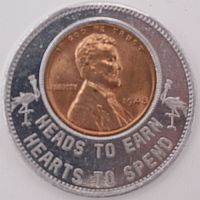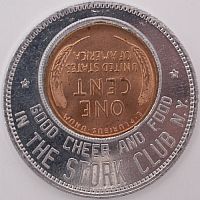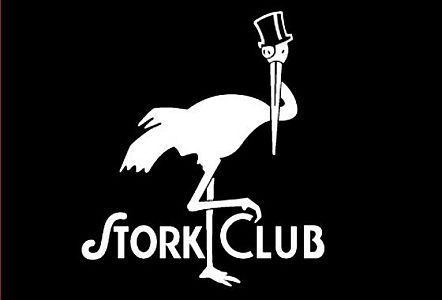
Introduction to the Stork Club Series
An ECI Article by James M. Lawniczak


Obverse reads: HEADS TO EARN HEARTS TO SPEND
- (Hover for larger image) Image by Perdue


Reverse reads: GOOD CHEER AND FOOD IN THE STORK CLUB N.Y.
(Hover for larger image) Image by Perdue

Image courtesy of eBayfrontinside cover, Public Domain, Link
Introduction to the Stork Club Series
© 2021 James M. Lawniczak All Rights Reserved (as it originally appeared on ECI)
According to a matchbook I saw for sale on eBay, the Stork Club was at 3 E. 53rd Street. It was still there in 1960
according to the NYC Business Classified Directory, with phone number PLaza 3-1940. It was listed at the above address
and phone number in the 1939 Manhattan Yellow pages under the personal supervision
of Sherman Billingsley. It may be
the most famous nightclub ever. It began during prohibition and lasted into the 1960s. Sherman Billingsley was the owner,
who someone told me was Barbara Walters’s father, but that is not correct. One of Sherman’s nephews married Barbara
Billingsley, who played the Beaver’s mother. Famous people hung out there.
The Stork Club made many encased pieces. My best guess from decades of watching their sales is that the first Stork Club encased was made in 1937 and the last in 1957. It was a long series, although not as long as the Gamler (Buffalo) series. I believe that the Stork Club made more total encased than any other business. For that reason, most of the Stork Club encased are very reasonably priced. But, I have seen common Stork Club pieces, available by the tens to hundreds for $5 or less, sell on eBay for over $100. This must be to people who do not know how common they are.
I have started the Stork Club encased with the number ST-100 to leave the under 100 numbers for other ST
New York
pieces.
[ ](NY)-(NYC)-ST-100. 1916, 1917D, 1918, 1919, 1919S, 1920, 1924, 1927, 1930, 1934, 1936 or 1937 [one stork on each side facing the cent, standing on one leg] Stork Club// Lucky Penny/ [small signature at bottom]: Osborne Register Co. Cinti. O.\\ [same reverse, except no signature]. This piece is beaded around the cent on both sides and has denticles around the rim on both sides. However, my 1919 and one 1937 piece are not beaded and does not look like the beads were poorly struck or worn off. I do not think that lack of beads is enough to make a separate piece though.
This seems to be the most common of the Stork Club encased pieces and was probably made for several years. Based on the
condition of cents that I have seen in these pieces, I guess that production started in 1936 and that any earlier dated
cents were circulated cents. There were at least two different dies, in order to strike both sides, but I have been
unable to identify any more than the two dies (for example, the right leg of the K
in Stork points down to the B
in the Osborne signature and the P
in Penny points to the C
in Co. on all the pieces I have seen). The
signature side faces the cent reverse on all pieces I have seen except the 1916 and 1917D, where it faces the obverse.
The 1917D cent is a VG in an AU encasement, but it would have been a circulated cent when inserted and it is in very tight
with no light showing and will not dislodge with maximum pressure. I paid $2 for it so my seller did not put an unusual
1910s mint mark cent in an encasement to make a profit. On some of the pieces the Osborne signature is very light.
JL, EB; JL; EB; JL; EB; JL, EB; JL, EB; EB; EB; JL; EB; JL $5
[ ](NY)-(NYC)-ST-102. 1937, 1938, 1939 or 1945, RD,32mm. Very similar to the -100 piece, with the same words and the
storks in about the same location, but these pieces are not denticled and there is no bead around the cent, just a line
around the cent obverse (on this piece there is nothing at all around the cent reverse), and also there is no Osborne
signature. The orientation of the stork is a bit different also, most noticeably in the stork on the right, whose bottom
foot points down at an angle towards the middle of the Y
in Lucky (standing on tiptoe so to speak). On the -100,
the foot is mostly horizontal (standing level), pointing across to the top right of the Y.
JL; EB; EB; JL, EB $5
[ ](NY)-(NYC)-ST-110. 1918, 1918S, 1919, 1920D, 1934, 1935, 1937 or 1938, RD,32mm. [one stork on each side facing towards the cent at 10:00 and 2:00, standing on one leg] Dinner/ [one word on each side of the cent at the foot of each stork] At The// Stork Club/ [small signature: Osborne Register Co. Cinti. O.\\ [same reverse except no signature]. The encasement is beaded around the cent on both sides, but there are no denticles. My guess is that the production of this piece began in the 1930s and that any earlier cents were circulated cents. EB; EB; EB; BS#37,70; JL; EB; EB; SA#42,865 $6
[ ](NY)-(NYC)-ST-120. 1936 or 1937, RD,32mm. [stork on each side facing the cent] Stork Club// Lucky Penny/ [small signature]: Beck N.Y.\\ [star on each side] Stork Club// Pennies from Heaven. This piece is denticled on each side. All Stork Club pieces were not made by Osborne; this one was by Beck. This is rarer than the generic Stork Club pieces listed above but is not uncommon. JL, PC#21,696; JL, VN, PC#21,697 $8
[ ](NY)-(NYC)-ST-130. 1936 or 1937, RD,32mm. [stork on each side of the cent] Stork Club// Lucky Penny\\ [the reverse is broken into three areas with two lines, separated by stars]: Gus Martel and/ His Rhumba Orchestra [star] Sonny Kendis/ and his Orchestra [star] Dinner- Supper/ - Dancing - [this segment is upside down]. This piece is also denticled. EB; JL $10
[ ](NY)-NYC-WF1-10/ST-140. 1938 or 1939, RD,32mm. New York World’s Fair/ [picture of the Trylon and Perisphere/ ©NYWF on the left side of the cent] 1939 [on the right side]// Stork Club\\ [same reverse]. CD Gale reports a 1939S for the Stork Club world’s fair piece, CD#13,1019, but it has not been verified as an authentic original cent. This, like many of the Stork Club pieces, must have been made in quantity, as it is very common and thus not all that expensive. Once in a while, the piece sells for an exorbitant amount to someone on eBay who must not know of its great availability. JL; JL $8
[ ](NY)-(NYC)-ST-150. 1940 or 1941, RD,32mm. [small star on each side] Good Luck// Stork Club\\ [each of the twelve symbols of the zodiac, around the cent, in order, starting at the top of the piece with the arrow pointing right, which is Sagittarius, then follow: Capricorn, Aquarius, Pisces, Aries, Taurus, Gemini, Cancer, Leo, Virgo, Libra and Scorpio -- so if you ever need a handy reference guide to the symbols of the zodiac, this piece is it] This piece is beaded and denticled. JL; JL, EB, DG#97,17 $8
[ ](NY)-NYC-ST-160. 1940, 1945, 1946 or 1948, RD-O,32mm. [small star on each side of the cent] Good Cheer and Food/ The Stork Club N.Y.\\ [stork on each side facing the cent] Heads to Earn/ Hearts to Spend. There is nothing above the cent, which is the short side on this off center piece. The piece is denticled and beaded, although all the beads did not always strike up. JL; JL; JL; JL $6
This is the first Stork Club piece that needed to say it was from New York. This piece often comes with a very original red uncirculated cent. My thinking is that many pieces were struck but never circulated, so that a hoard of uncirculated pieces was available for collectors. This is the same thing that happened to many of the Fankhauser encased and also why there are so many uncirculated Fankhausers available today.
In 1999 I came across a hoard of 100 pieces with replaced 1955, 1956 and 1957 cents. What apparently happened is that
quite a few of these off center pieces were struck, unknown when, without cents at all, and a dealer put in 1955-1957
cents to make them look better. These were again for sale in Coins magazine in 2000 properly described as having the
cents inserted after striking. However, someone who bought these from the dealer, who was correctly describing them,
later began selling interesting varieties
on eBay: 1943, 1943D and 1943S uncirculated cents; all replaced cents, of
course. I still see some of the 1955, 1956 or 1957 cents for sale on occasion. The 1956 plain cent is so rare in an
encasement that I have never seen one in an original to the time aluminum encasement.
[ ] (NY)-(NYC)-ST-170. 1948, RD,32mm, brass. Stork Club/ [stork to left facing cent] 1949 [to right of cent]// Lucky
Penny/ [small signature]: Osborne Coinage Cin. O.\\ [stork on each side of cent] Stork Club// Lucky Penny. This is not
all that rare a piece. When it came on for sale on eBay in October 2003, the seller stated that it was valued at
$75-$100.
I wonder who did that valuation? The piece supposedly sold for $100.99. JL $15
[ ] (NY)-(NYC)-ST-172. 1948D, 1949 or 1949D, RD,32mm, brass. Same as the 1949, -170 piece, except here the year on the encasement is 1950 instead of 1949 as on the -170. JL, EB; JL; JL, EB $15
[ ] (NY)-(NYC)-ST-174. 1956D, RD,32mm. Stork Club/ [stork to the left of the cent facing the cent] 1957 [to the right of the cent]// Lucky Penny\\ KMANGB. This is the only Stork Club piece I know of with a standard lucky slogan reverse! There is no Osborne signature on this piece, but it looks like a Fankhauser and so was almost certainly made by Osborne. I think this is the scarcest of the Stork Club pieces, as the one I have is the only one of these I have ever seen or heard of. Maybe it should be valued at hundreds? Maybe there are more pieces, equally scarce, between 1950 and 1956. JL $12
[ ] (NY)-(NYC)-ST-174. 1956D, RD,32mm. Stork Club/ [stork to the left of the cent facing the cent] 1957 [to the right of the cent]// Lucky Penny\\ KMANGB. This is the only Stork Club piece I know of with a standard lucky slogan reverse! There is no Osborne signature on this piece, but it looks like a Fankhauser and so was almost certainly made by Osborne. I think this is the scarcest of the Stork Club pieces, as the one I have is the only one of these I have ever seen or heard of. Maybe it should be valued at hundreds? Maybe there are more pieces, equally scarce, between 1950 and 1956. JL $12
Editors note - All the above content was provided by James M. Lawniczak © 2021 All Rights Reserved. The content has not been edited or fact checked.
The following are comments regarding my experience with Stork Club encased cents and with the Osborne Coin Company - Editor
- Regarding the reference to "Beaver" in the first paragraph, this is from the TV show "Leave it to Beaver" a popular American television sitcom broadcast between 1957 and 1963.
- Jim claims that these pieces were made by the Osborne Coin Company of Cincinnatti and some were sold to them by Earl Fankhauser. In reviewing the work orders for Osborne that Bryan Ryker collected many years ago in his reasearch of "The Penny Man" I find no work orders for The Stork Club. These work orders start in 1946 and continue until Osborne stopped producing encased coins in the late 1960's.
- The prices quotes here were current when the article was written for ECI, but do not reflect the current market on eBay. (Your Milage May Vary...)
This is an edit 1/12/22 - I have found evidence that the 1948 D brass encased cent for The Stork Club was made by Osborne Coinage. In examinimng the 1948 D I saw in tiny letters at the bottom of the reverse, Osborne Coinage, Cin, O.

While this does not prove that Earl Fankhauser sold these pieces, it does prove that Osborne Coinage manufactured them.
Home | Articles | Varieties | Coin Links | About | Terms of Use
Site Copyright 1999-2021 by Bruce Perdue Email: Webmaster All Rights Reserved ©Copyright Bruce Perdue